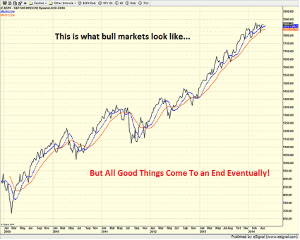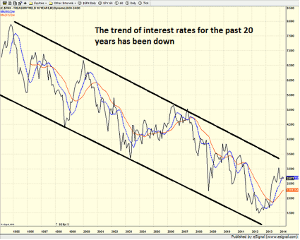Given that this bull has run a long way and could be getting tired, it’s a good idea to be on the lookout for potential bear market catalysts, says David Moenning of StateoftheMarkets.com.
To be sure, the current stock market environment is challenging. Intraday volatility is quite high, the major indices are not marching to the beat of the same drum, and holding the wrong stock or sector ETF has proved to be a frightening affair in 2014.
In case you can't relate to this sentiment, check out the charts of the ETFs in biotech (XBI), internet (FDN), and social media (SOCL) or names like Netflix (NFLX), Amazon.com (AMZN), Linked-In (LNKD), Pandora (P), Yelp (YELP), and Twitter (TWTR).
In short, the action has been more than a little scary at times. This is a market where it has been oh-so easy to lose money and with the exception of the strategy of being long only on Tuesdays (according to Bespoke, being long on Tuesdays would have produced a gain of 9%, so far, this year), making money has been downright difficult.
Time for Bears to Return?
The action has left many analysts worried that the current bull market, which is clearly long in the tooth by just about any measure, could be slowly morphing into something far grizzlier in nature. As such, this might be a good time to review what might cause the bears to suddenly awaken from their hibernation and begin wreaking havoc on people's investment portfolios again.
But before we get started on a review of potential bear market catalysts, let's remember that, as the chart below of the S&P 500 plotted weekly clearly illustrates, this remains a bull market.
S&P 500 Weekly
However, if investors have learned anything over the last 15 years, it is that (a) all good things come to an end, and (b) bear markets are no fun (and should be avoided if at all possible).
So, given that this bull has run a long way and as it can be argued, is looking a little tired, it is a good idea to be on the lookout for potential bear market catalysts.
We've come up with about a dozen. So, let's review.
Bear Market Catalysts
Fed Surprise: Experienced investors know that markets don't like surprises—especially when it comes to the Federal Reserve. One of the oldest clichés on Wall Street is "Don't fight the Fed." Remember, the Fed usually gets what it wants. So, if Ms. Yellen and her merry band of central bankers suddenly have to make a course correction due to inflation or some such thing, stocks will NOT react well.
Therefore, it is a good idea to listen carefully to everything the Fed says and writes these days. The bottom line here is that this bull has been sponsored in large part by the Fed's uber-easy monetary policies and the QE money printing programs. And while Bernanke and Yellen have gone out of their way to try and provide an expected course of action for the Fed to follow, if they were forced to take a different tack, well, it might not be pretty.
A Real Crisis: Investors have grown accustomed to market crises over the past seven years or so. One could argue that traders even have a play book to follow whenever a crisis occurs. But this doesn't mean that stocks won't react—and react swiftly—the next time a real crisis comes along.
NEXT PAGE: 3 More Bear Market Catalysts
|pagebreak|We're not talking about the little hiccup seen earlier in the year that was caused by capital flowing out of the emerging markets. And we're not talking about what, so far at least, has been a relatively tame crisis in Ukraine.
No, we're talking about a REAL crisis. A crisis that threatens the economy or, more importantly, the global banking system. Such an event would most certainly cause traders to get busy on the sell side again for a protracted length of time.
Recession: The granddaddy of all bear market catalysts occurs when the US economy encounters a recessionary period. When the economy contracts for two quarters or more, the amount of money investors are willing to pay for a dollar of EPS shrinks wildly. Suddenly, the idea of a growth premium is thrown out the window and investors are much more focused on the return OF their money than the return on their money.
The good news is that there is very little chance of a recession at the present time. The soft-patch caused by the dismal winter appears to have ended and the numbers are starting to rebound. But investors should continue to be on the lookout for anything that suggest the current economic expansion might be slowing.
Inflation: While it may be hard to argue that inflation in and of itself could be the sole cause a bear market in stocks, many bear markets have been accompanied by bouts of inflation. For the past five years, inflation has been almost non-existent and the Fed tells us that inflation is not going to be a problem any time soon.
However, we must recognize that the economy IS improving and the Fed has been printing money hand-over fist for an inordinate length of time. And if you will recall from your Econ 100 course work, too many dollars chasing too few goods is the very definition of inflation.
So, investors need to be on the lookout for the time when a whiff of inflation suddenly becomes a wave. Because as anyone who was around in the late 1970's can attest, once inflation starts to roll, it can be very tough to stop. The bottom line here is that if inflation—as measured by the CPI—starts climbing above 2% for a while, stocks could be in trouble as inflation has been one of the biggest historical catalysts of bear markets.
Rising Rates: This potential bear market catalyst is really an offshoot of the "Don't fight the Fed" concept. In short, history shows that when rates are rising, stocks tend to underperform.
This time around however, things are a little tricky as rates have been kept artificially low for quite some time. As such, most analysts agree that if there are no global crises and the US economy starts to moves up in earnest, the only way for interest rates to go is up.
10-Year Treasury Yields – Monthly
Remember, if rates rise, interest-bearing instruments become competition for stocks. Thus, if rates were to break out of the long-term downtrend that has been in place for more than 20 years, it is easy to see why investors might start selling stocks. This is simply how the world has always worked. The bottom line here is if the monthly yield on the 10-year rises above 3.5%, it could be a big problem for the stock market.
Next time, we'll look at another handful of potential bear market catalysts including wars, idiots in DC, extreme valuation, time, and some technical breakdowns.
By David Moenning of StateoftheMarkets.com























